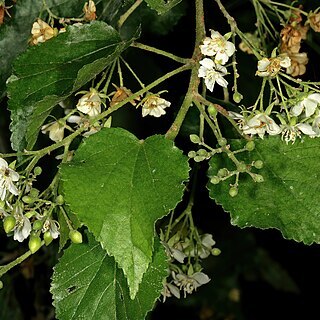Small tree or shrub, 1.2-7.6 m high. Stipules early deciduous. Leaves thin-textured, ovate, acuminate, rounded or shallowly cordate at base, margins crenate; sparsely and coarsely stellate-pubescent on both surfaces. Inflorescences cymose, 3-12-flowered, axillary in upper leaves of main and short lateral branches; peduncles slender, 10-30 mm long; pedicels coarsely stellate-tomentose. Flowers 6-8 mm long, white, aging rusty brown. Sepals with lobes 4-5 mm long, stellate-pubescent on outside. Petals persistent. Flowering time Aug.-May. Fruit a capsule, ± 4 mm long, stellate-tomentose. Seed solitary, filling capsule.
Leaf-lamina up to 10 × 7·5 cm., ovate, apex acuminate, margin crenate, base cordate and 5–7-nerved, minutely and sparsely pubescent on both surfaces or almost entirely glabrous with a few hairs near the base of the midrib; petiole up to 4 cm. long, slender, pilose or glabrous; stipules 2–3 mm. long, very caducous, filiform, pubescent or tomentose.
Small tree or shrub, up to 3 m high. Leaves rather thin in texture, ovate, gradually narrowing in upper third and then abruptly acuminate towards apex, smaller than 70 x 60 mm. Flowers 6-8 mm long, 4-5 mm broad. Peduncles with short stellate hairs. Flowers white, turning rusty brown with age.
Flowers white, in axillary panicles; peduncle up to 2·7 cm. long, slender, sparsely and densely flocculose-pubescent; pedicels up to 1 cm. long, with a similar indumentum; bracts c. 1·5 mm. long, linear, dispersed along the pedicels, pubescent.
Ovary depressed-globose, densely pubescent to shortly tomentose; loculi glabrous within; ovules 2 per loculus; style c. 3 mm. long, glabrous; stigmas 3, 1–1·5 mm. long, spreading or recurved.
Calyx-lobes up to 7·5 × 2 mm., narrowly lanceolate-acuminate, pubescent outside or quite glabrous except at the base.
Shrub or small tree up to 8 m. tall; bark whitish; young branches thinly pubescent or quite glabrous.
Stamens united below in a tube c. 1 mm. long; staminodes c. 5 mm. long, linear.
Capsule c. 3–5 mm. in diam., globose, pubescent, often single-seeded.
Seed c. 3 × 2·5 mm., brown, ovoid; testa very minutely roughened.
Petals c. 1·7 cm. long, very obliquely cuneate.


